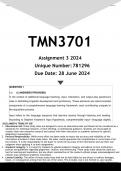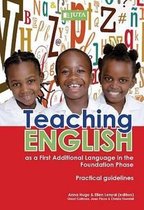TMN3701
Assignment 3 2024
Unique Number: 781296
Due Date: 28 June 2024
QUESTION 1
1.1. (2 ANSWERS PROVIDED)
In the context of additional language teaching, input, interaction, and output play paramount
roles in facilitating linguistic development and proficiency. These elements are interconnected
components of a comprehensive language learning framework, each contributing uniquely to
the acquisition process.
Input refers to the language exposure that learners receive through listening and reading.
According to Stephen Krashen's Input Hypothesis, comprehensible input—language slightly
DISCLAIMER
above&theTERMS OF USEcurrent proficiency level—is essential for language acquisition. When
learner’s
1. Educational Aid: These study notes are designed to serve as educational aids and should not be considered as a
substitute for individual research, critical thinking, or professional guidance. Students are encouraged to
conduct their own extensive research and consult with their instructors or academic advisors for specific
assignment requirements.
2. Personal Responsibility: While every effort has been made to ensure the accuracy and reliability of the
information provided in these study notes, the seller cannot guarantee the completeness or correctness of all
the content. It is the responsibility of the buyer to verify the accuracy of the information and use their own
judgment when applying it to their assignments.
3. Academic Integrity: It is crucial for students to uphold academic integrity and adhere to their institution's
policies and guidelines regarding plagiarism, citation, and referencing. These study notes should be used as a
tool for learning and inspiration, but any direct reproduction of the content without proper acknowledgment and
citation may constitute academic misconduct.
4. Limited Liability: The seller of these study notes shall not be held liable for any direct or indirect damages,
losses, or consequences arising from the use of the notes. This includes, but is not limited to, poor grades,
academic penalties, or any other negative outcomes resulting from the application or misuse of the information
provided.
]
, For additional support +27 81 278 3372
QUESTION 1
1.1. (2 ANSWERS PROVIDED)
In the context of additional language teaching, input, interaction, and output play pivotal roles in
fostering effective language acquisition. These three components form the backbone of
comprehensible and meaningful language development.
Input, which refers to the exposure learners have to the target language, is crucial. However, it
isn’t just any input that supports learning; it has to be comprehensible input, as posited by
Krashen's Input Hypothesis. This means that the language content must be understandable to
the learner, slightly above their current proficiency level (i+1), which challenges them and
prompts learning. For instance, a teacher might use visual aids, gestures, and simplified
language to ensure students grasp new vocabulary and structures. In a classroom setting,
comprehensible input can come from listening to the teacher, watching videos, or reading texts
that are appropriately pitched at the learners' level.
Interaction, as highlighted by Ellis and Shintani (2014), serves a dual purpose. Firstly, it primes
students for learning as it involves both listening and speaking, thus promoting active
engagement. Interaction is the crucible where negotiation of meaning takes place, which is vital
for understanding and internalizing new language forms. Group discussions, role plays, and
interactive activities not only encourage student talk but also necessitate listening and
comprehending peers' contributions. Through such interactions, learners encounter new
linguistic forms and meanings, facilitating deeper processing of language input. For example, in
a task-based learning activity, students might discuss a problem and collaborate on a solution,
implicitly absorbing correct language usage and structures through this social exchange.
Output is the third crucial element and refers to the language the learners produce—speaking
or writing. According to the Output Hypothesis formulated by Swain, producing language (output)
compels learners to process language at a deeper level. This production process allows learners
to test hypotheses about language rules and receive immediate feedback, which is essential for
language modification and refinement. For instance, when learners engage in conversational
practice or write essays, they are pushed to articulate their thoughts clearly and accurately, often
needing to adjust their language to be understood correctly. This active use of language fosters
not only fluency but also grammatical accuracy and complexity.
Thus, input, interaction, and output are intertwined in a dynamic process that supports language
acquisition. By providing comprehensible input, facilitating meaningful interaction, and
encouraging active language production, educators can create an environment where learners





